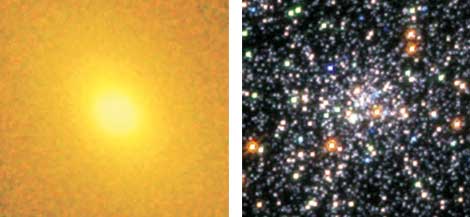As any seasoned amateur observer can tell you, the star density in the center of globular clusters is high. In the densest globular-cluster cores, not even the largest Earth-bound observatories can resolve individual stars.
The Hubble Space Telescope (HST) can do it, though, and it gives astronomers a chance to determine a core’s density with reasonable accuracy. M15’s center packs approximately 4 million stars per cubic parsec — that’s more than 75 million times denser than the region around the Sun. This works out to an average of only 0.013 light-year, or 860 astronomical units (1 AU is the average Earth-Sun distance), between stars. Most galaxies, such as M31 in Andromeda, M33 in Triangulum, and the Milky Way have central densities close to this value — an average separation of 0.013 light-year.
But some galaxies pack stars even tighter. M32, one of the Andromeda Galaxy’s satellites, has the highest measured stellar density of any nearby galaxy — around 20 million stars per cubic parsec in its core! Not even HST can resolve M32’s core into individual stars. A typical stellar separation at this density works out to 0.008 light-year, or 500 AU — about 12 times the Sun-Pluto distance — between stars.
Tod Lauer of the National Optical Astronomy Observatory calculated that observers at the center of M32 would find a “night sky” as bright as twilight on Earth.
Even at these high star densities, collisions are rare. Globular clusters have stars in their centers called “blue stragglers,” which astronomers think are new, massive stars formed by the collision of two old, lower-mass stars. Fewer than one in every 10,000 globular-cluster stars are blue stragglers, which suggests how rare stellar collisions are even in these extreme environments.










